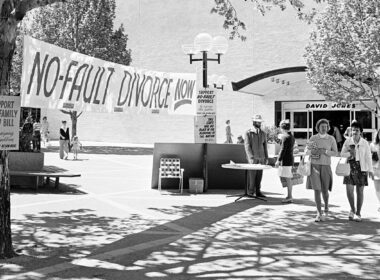When we say slavery, a lot of people still think chains and restraints and state-sanctioned ownership – contemporary slavery is not that, yet it is still happening all the time.
It's the crime we look at but don't see. Slavery is alive and well in Australia in 2019, but would you know how to recognise it?
Construction workers brought to Australia on the promise of a better life and forced to work for hours and days on end, living in shipping containers with one small door for ventilation.
Housekeepers locked away, their passports seized and pledges of permanent residency disappearing in endless days of domestic labour.
Young people sent away as child soldiers or brides. Debt bondage, where a loan is given and the interest piled on, giving its recipient no chance of ever repaying it.
Coercion and threats designed to trap victims in their dire situations.
This is slavery in 2019. And Australia is not immune.
On 1 January this year, the Modern Slavery Act 2018 (Cth) commenced, stipulating new reporting requirements for businesses with a turnover of $100 million or more with options for smaller businesses to report voluntarily.
But despite this new legislation demanding greater accountability, many experts believe there remains a lack of understanding about what modern slavery actually looks like – and this causes confusion that complicates any effort to combat it.

Slavery through a modern lens
“People still think of slavery as people in chains being taken across the ocean,” says Carolyn Kitto, Co-director of the Australian chapter of Stop the Traffik, a coalition of civil society, community and other organisations working together against trafficking in Australia and around the world.
“Slavery looks quite different in this day and age. We look but we don’t see it, we eat it but we don’t taste it, we touch it but we don’t feel it. It’s a crime – a hidden crime, an organised crime with slave traders who are smart and who keep changing their methods.”
Heather Moore, a policy expert who was instrumental in the drafting of the Commonwealth Modern Slavery Act and who now works at Monash University as well as being Policy and Advocacy Adviser for the Salvation Army’s Freedom Partnership to End Modern Slavery, says most people do understand that modern slavery exists but many are unsure about how exactly it happens in reality.
“I don’t have to convince people it’s a thing anymore. Now we have been able to move on and instead focus on how it manifests. There has been a lot of work to get to this point,” she says.
“The extent to which businesses have known [modern slavery was happening in their supply chains] has been overestimated. My observation has been it’s a lack of understanding. There is a failure to comprehend the subtle forms of coercion.
“When we say slavery, a lot of people still think chains and restraints and state-sanctioned ownership – contemporary slavery is not that, yet it is still happening all the time.”
There have only been 23 convictions of any slavery or trafficking offences since 2004 and Moore believes “the whole system is underexposed to this crime type”. More can be done, she says, to support victims and engage them in the justice process.
 Heather Moore
Heather Moore
The human face of modern slavery
In Sydney, the Salvation Army operates the Safe House, the only women’s refuge in Australia for women who have experienced slavery and trafficking.
In one case, Cassandra (not her real name) travelled to Sydney to begin work as a housekeeper after being promised paid work and a pathway to permanent residency by a family she had assisted overseas.
Soon after she arrived, her employers took her passport. She was forced to work around the clock, doing all the washing, ironing, cooking, caring for the dogs and cleaning the swimming pool. She was routinely threatened, sworn at and banned from leaving the house. She could not contact her family. Her whole life was under their control.

For three years she worked without pay. There was no sign of her application for permanent residency. She feared for her safety. After a chance opportunity to alert a neighbour, a call was made to the Department of Immigration and she was freed from the house. Through the Safe House, Cassandra has been able to rebuild her life and now lives independently while working as a nursing assistant.
At any given time, the Safe House can sleep up to 10 women but, together with accommodation and case management, they generally can support 25 to 30 women. Demand is always high.
The Safe House estimates that domestic servitude accounts for most instances of slavery in Australia.
“Typically, someone is placed in a family home. They receive little or no pay. Their passport is [taken]. They have no freedom. There are huge elements of coercion, power and control. Often [it] remains very much unseen,” a Safe House staff member tells LSJ.
“The Safe House aims to never turn someone away, even if it is just to offer advice, emergency material aid, or a referral to another service. A residential client will usually stay for 12 months to two years. The Safe House also supports people regardless of whether or not they choose to cooperate with law enforcement in an investigation of the perpetrator.
“Many do not want to go down the path of a prosecution, as they hold continued fears for their safety. Everyone is different. Many people will continue to be fearful for a very long time. Once they feel safe it may be different and they feel more assured in going through that process.”
 Carolyn Kitto
Carolyn Kitto
Slavery looks quite different in this day and age. We look but we don’t see it, we eat it but we don’t taste it, we touch it but we don’t feel it. It’s a crime – a hidden crime.
Wage theft or something more?
Moore believes there remains some confusion about what constitutes a civil breach and what is against the criminal law – and the muddying of the waters has been exacerbated by recent scandals of underpayment of wages in the hospitality industry.
She points to recent coverage of cases involving celebrity chefs George Calombaris and Neil Perry, and subsequent comparisons to slavery.
“There is currently a lot of noise in this space and a lot of describing underpayment or excessive overtime as a form of modern slavery, and that has an adverse reaction … the term should not be invoked for political gain,” Moore says.
“I am not at all diminishing the gravity of the problem of wage theft, but it’s not slavery, it’s not servitude. It’s not appropriate to apply the same terms.
“In determining whether it is a case of modern slavery, the question must be asked: ‘Why can’t you leave?’ When we are talking about slavery, we are talking about a person who cannot leave, usually due to threats made against them or their family.”

Kitto also says the likening of those cases – where Calombaris’ company was found to have underpaid staff by $8 million – and servitude, while serious, are not helpful.
“Situations of slavery can be found in our food, our clothing, our electronics – yet people don’t always see it when it is there. But when someone isn’t being paid enough [in a standard job] we say, ‘Oh, that’s slavery’,” she says.
Kitto points to a recent case where there was an application for an Australian visa by a former child soldier who had been forced to serve in the Middle East.
“Being forced to be a solider is a form of slavery, but the case was not described in those terms,” she says.
“We need to consider the layers of deception and trickery that are taking place and the vulnerability of the victims, such as women, children and refugees.”
 Laura Vidal
Laura Vidal
Australia is unique in framing forced marriage within the context of slavery.
Enforced marriage: slavery, domestic violence or both?
Another question for policymakers is where forced marriage – a crime often committed against children – should sit in the criminal justice system and how best to respond to it.
Forced marriage is a crime often detected before the minor is flown overseas for a ceremony. Often, those who suspect the marriage is about to take place contact the Australian Federal Police, who then place the child on a no-fly list.
However, under the Modern Slavery Act 2018 (NSW), which passed through NSW Parliament last year before the state election, there is also a mechanism for NSW police to charge those found to have facilitated the forced marriage. Experts believe this will lead to confusion, however, about who to turn to for help.
Laura Vidal, a policy specialist from Good Shepherd, a non-government organisation that works with women and girls experiencing disadvantage including forced marriage, believes it is a mistake to exclude the practice from the framework of family violence.
Prosecutions can be difficult, she says, as they will often involve a young person having to give evidence against their parents or other close relatives.
“Australia is unique in framing forced marriage within the context of slavery,” Vidal tells LSJ.
“The definition of domestic and family violence nationwide should be expanded to include forced marriage.
“A more nuanced approach is needed, rather than leaving it to businesses to guess and potentially misidentify forced marriage taking place in their corporate supply chains.”
Moore is also concerned that the apparent duplication of offences of forced marriage in state and federal acts will disrupt reporting.
“Who does the school principal contact if they suspect [child forced marriage] is about to take place?”
Moore asks.
“Are companies like Woolworths and Nestle really going to be able to track who is at risk of forced marriage [in their supply chains]?”
Kitto, on the other hand, believes forced marriage is a different crime to that of domestic and family violence and that it should indeed be considered in the context of modern slavery and responded to accordingly.
“When there has been information collected from victims of forced marriage, many do not identify as victims of domestic violence,” she says, adding that mining and construction companies that work in “geographically or culturally isolated areas” have already recognised the need to track the practice through their supply chains.
 Jennifer Burn
Jennifer Burn
The NSW Modern Slavery Act will help combat exploitative crimes that impact some of the most vulnerable people in our community.
Taking on the system
Moore believes more could be done to engage victims who may wish to participate in the criminal justice process, which is something she experienced working in the US at the turn of the century.
“When I worked [there], the authorities would ask me to work with victims, to build up trust that would assist in supporting them with going through the criminal justice system,” she says.
“In Australia, often the story will be that the victim wanted to be repatriated, and they just wanted to go home. I am not suggesting we coerce people into being witnesses, but we need to provide support to engage with them.
“We don’t know what happens to people afterwards. We do know there is evidence that many go on to be re-trafficked elsewhere.”
Vidal also notes a need to support victims who do not co-operate with criminal investigations and feel vulnerable; traumatised by what they have endured and facing an uncertain future either in Australia or overseas. She believes there must be “a de-linking” of the necessity of victims of forced marriage to engage with the criminal justice system in order to receive support.
“Support for victims should be based on need,” she says, “not on their participation in the criminal justice process.”
NSW laws in limbo
The NSW Modern Slavery Act is more forceful than its federal counterpart, requiring businesses with an annual turnover of $50 million to abide by reporting requirements for their supply chains and, crucially, imposing penalties for non-compliance.
According to the NSW Government, the Act “recognises modern slavery is prevalent around the world and in NSW and sets out steps to ensure NSW is not contributing to these crimes. [It] signals a commitment to promoting a safe and fair society for everyone. It establishes appropriate state-based responses to drive genuine change to combat modern slavery.”
However, implementation has stalled. During the August sitting week when Parliamentry debate over the Reproductive Health Care Reform Bill raged long into the night, the Legislative Council Standing Committee on Social Issues began an inquiry into the NSW Modern Slavery Act, the Modern Slavery Amendment Bill, and the draft Regulation.
The inquiry will examine the operability of the proposed anti-slavery scheme, the effect of supply-chain reporting on businesses, and whether the passing of the Commonwealth Act renders parts or all of the state Act unnecessary.
The NSW interim anti-slavery Commissioner Jennifer Burn urges any interested stakeholders to make a submission before the 4 October deadline.
“Modern slavery is an egregious breach of an individual’s human rights,” Burn says.
“The [inquiry] will provide the community, business and civil society a further opportunity to shape the Government’s response to modern slavery.”
Law Society of NSW Councillor Catherine James says putting the laws into practice and keeping potential victims safe is a critically important issue.
James suggests practical guidance can be developed for businesses to understand their new responsibilities under the Act.
Kitto believes that, with adjustments, the NSW Act has the ability to be “a real Modern Slavery Act”, whereas the Commonwealth Act is “a transparency and supply chain act”.
“The penalties [for non-compliance] are really important,” she says. “We have a taxation system, but we don’t say, ‘We would really like you to pay tax, but no penalties if you don’t’. It is a way of enforcing this.
“The solution is a shared responsibility. We must work collaboratively and in coalition.”




